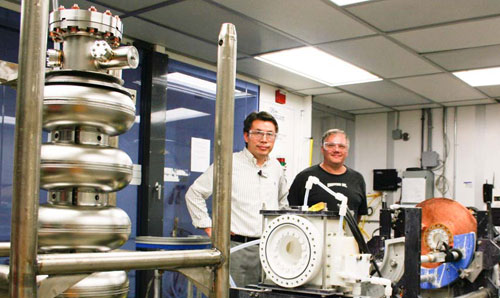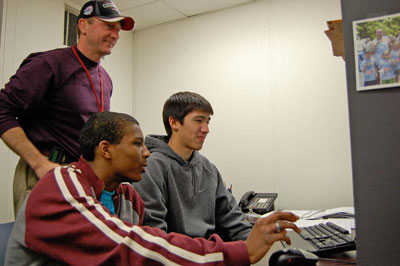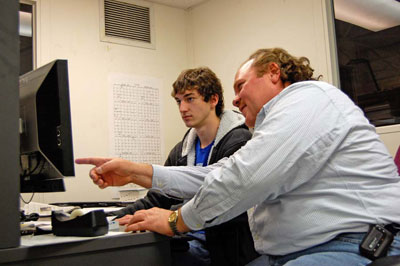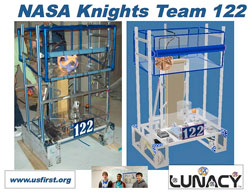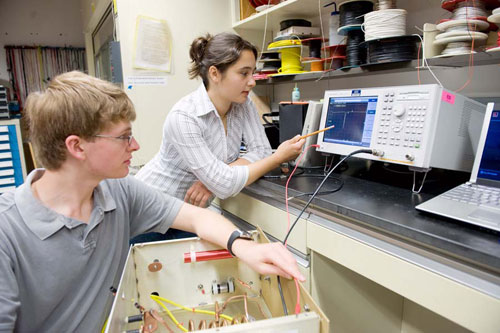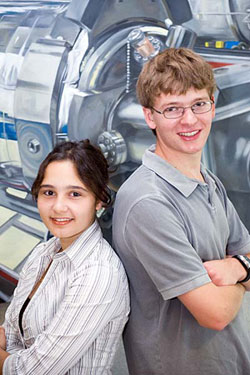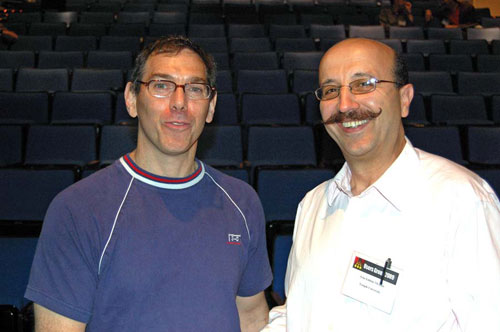
|
September 2009
|
|
|
The U.S. Department of Energy's Thomas Jefferson National Accelerator Facility
|
|
American-Made SRF Cavity Makes the Grade |
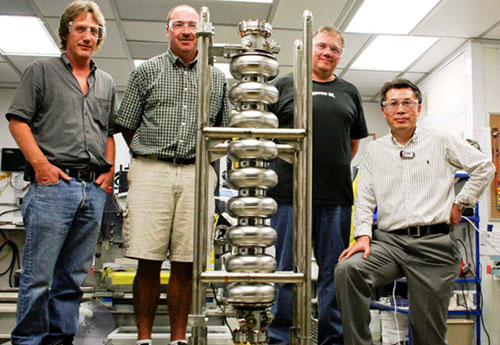 From left, JLab's Danny Forehand and Roland Overton, Fermilab's Jim Follkie and JLab's Rongli Geng take a break from cavity testing and processing to celebrate the milestone achieved with the pictured cavity, AES8. It was the first American-made cavity to surpass the ILC Global Design Effort specification of 35 MV/m. Cavity AES8 achieved 41 megavolts per meter during testing. JLab team members Byron Golden and Pete Kushnick are not pictured
Jefferson Lab marked a step forward in the field of advanced particle accelerator technology with the successful test of the first U.S.-built superconducting radiofrequency niobium cavity to meet the exacting specifications of the proposed International Linear Collider. Superconducting radiofrequency accelerator cavities are crucial components of particle accelerators or colliders, harnessing the energy that the collider pumps into a beam of particles. If it were built, the ILC would require about 16,000 niobium cavities, and vendors worldwide are vying to produce test cavities that meet the ILC's stringent performance goals....... more |
|
|
Ciovati Honored with Presidential Early Career Award
|
Empty Space in CEBAF Helps Make Upgrade Possible
|
BEAMS: JLab’s Science, Math Outreach Program Needs Your Help
|
||
|
|
||||
Below the Fold:
|
||||
Ciovati Honored with Presidential Early Career Award |
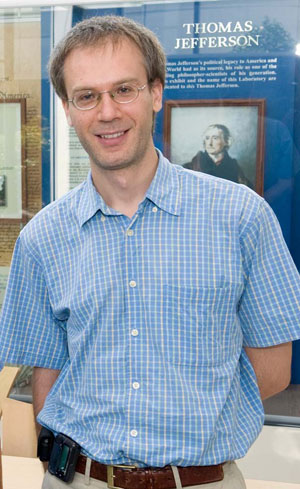 Gianluigi Ciovati
In the fall, Gianluigi (Gigi) Ciovati will visit the White House to receive a 2009 Presidential Early Career Award for Scientists and Engineers, the highest honor bestowed by the U.S. government on outstanding scientists and engineers who are early in their independent research careers. In addition to a citation and a plaque, each PECASE winner receives up to five years of funding from their agency to advance his or her research. This year, 100 young scientists and engineers were chosen for the honor, with 12 researchers from the Department of Energy. For Ciovati, the work that led him to that moment began at INFN-Milan (Italy's National Institute of Nuclear Physics), where, with a graduate degree, he helped design accelerator cavities for a European accelerator designed to transmute nuclear waste into safer materials. The accelerator was designed, much like CEBAF, to use superconducting radiofrequency (SRF) accelerator cavity technology. From there, Ciovati moved on to the design of SRF accelerator cavities for other projects, including the Spallation Neutron Source. "Our design was the final choice for the SNS," Ciovati said. "And then it was also decided that the SNS superconducting linac was going to be built at Jefferson Lab. So, during those times, Peter Kneisel came to visit the lab in Milano and I was introduced to him." Ciovati moved to Jefferson Lab to work on the SNS project and soon also began work on his Ph.D. at Old Dominion University. While at ODU, he continued to work at Jefferson Lab part time. "I worked on the design of one of the two types of cavities proposed for the CEBAF upgrade. Then I worked on the prototyping," he said. Ciovati earned his Ph.D. from ODU in 2005. Since coming to Jefferson Lab, one aspect of SRF cavity performance has particularly intrigued Ciovati: Why do cavities fail due to a condition known as Q-drop? "The easiest way you can think about it is with a pendulum. The Q tells you how long it will take for a pendulum, once you set it in motion, to stop. So the more efficient it is, the longer it's going to oscillate," Ciovati explained. An accelerator cavity is a resonator. By ringing like a bell, it stores the energy pumped into it, which can then be absorbed by a charged-particle beam, thus accelerating it. When a cavity is experiencing Q-drop, it reaches a limit in its efficiency for storing energy. In such a cavity, a threshold is reached, where the more energy that is forced into the cavity, the more that is dissipated in the cavity wall and, therefore, the less that is available to be transferred to the beam. "And there is a kind of empirical method to try to alleviate that, but it doesn't always work. And so my work has been to devise some models to try to test and identify what are the causes of this Q-drop, and eventually how to resolve it," Ciovati explained. Oct. 1 Colloquium Features Award Winner
A special colloquium, High-Field Losses in SRF Cavities, will be presented by Gianluigi Ciovati, Accelerator Division SRF Institute, on Thursday, Oct. 1 from 3:30 to 4:30 p.m. in the CEBAF Center auditorium. He is a 2009 recipient of the Presidential Early Career Award for Scientists and Engineers. During the colloquium he will discuss the performance of superconducting radiofrequency cavities made of bulk niobium at high RF fields (peak surface magnetic field greater than about 90 mT). His current line of research focuses on magnetic vortices inside the niobium metal skin of the cavities. These vortices are like little swirls of magnetic field that can interfere with the energy being pumped into the cavity. In one line of research, in collaboration with Ganapati Myneni at JLab and North Carolina State University, he is studying how to prevent these vortices from being trapped near the inner surface of the niobium cavity. Currently, the magnetic vortices are thought to be trapped in contaminants, such as hydrogen and oxygen clusters, sitting just under the surface of the niobium metal that has undergone standard cavity processing. There is a potential for trapping the vortices any time the metal is cooled below the superconducting critical temperature in the presence of a residual magnetic field (such as the Earth’s magnetic field) or when there is a large range of temperatures along the cavity. A high-temperature heat treatment in a vacuum furnace is already part of the standard cavity processing procedure to reduce the amount of hydrogen in niobium. But impurities can also be introduced through this process. "We think that the key point is that when the furnace cools down, niobium is a very good getter for these kinds of impurities. So, there are residual gases that are left in the furnace, such as hydrogen and oxygen that will eventually be re-absorbed on the surface," he said. To find out, Ciovati aims to build a "clean furnace," where he can control the gases inside the furnace as the niobium cools down. "So, the idea is that, if you were to admit low partial pressure of nitrogen at the proper temperature for the proper pressure and time, you will be able to form a thin layer of niobium nitride, which would prevent the re-absorption of those other gases. The point is to make it thin enough where it doesn't disturb much of the superconducting properties of the niobium." The other focus of his research, the fruit of a collaboration with Alex Gurevich at Florida State University, is to try to stamp out vortices already present in niobium accelerator cavities. The vortices show up in accelerating tests as hot spots on the cavities' cold, superconducting surface. Ciovati thinks that the vortices, and those tell-tale hotspots, might be chased away from the cavity's surface by a laser. "Our idea is to try to definitely prove that by shining a laser on the spot where we see these additional losses and use the laser as what we call a thermal broom. It's going to push them deeper in the material," he said. Ciovati said that his work could potentially benefit many accelerator projects, including the 12 GeV Upgrade project at Jefferson Lab. "For the cavities for the CEBAF upgrade, there is one already observed kind of roll off of the Q close to the operating point. This is close to the onset of the corresponding magnetic field where this Q-drop occurs. And if a suitable remedy for it would be devised, it would help CEBAF." By Kandice Carter |
Empty Space in CEBAF Helps Make Upgrade Possible |
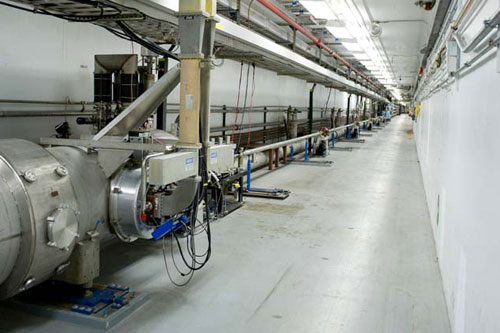 The empty space in the CEBAF linear accelerator sections will be filled with 10 new cryomodules as part of the 12 GeV Upgrade, doubling the energy of JLab's electron beam from 6 Giga-electron Volts to 12 GeV.
Jefferson Lab's Continuous Electron Beam Accelerator Facility is set to undergo its first major upgrade, a $310 million project to enhance the facility's research capabilities. To make it possible, designers are filling in "extra space" in the linear accelerators or straight sections of the machine with additional accelerator components. But where did that extra space come from? According to Andrew Hutton, associate director of the Accelerator Division, the space is the result of a trade-off made nearly 25 years ago when the accelerator was being constructed. "Somewhere along the way, which is often the case in a construction project, money started to become tight," Hutton says. So, scientists explored ways to cut costs. One idea called for using fewer accelerating components, called cryomodules, in the machine. At that time, cryomodules cost around $1 million each. They contain the equipment that "accelerate" the electrons, essentially giving them more energy. The accelerator design then under construction called for sending the electrons through the two linear sections of cryomodules up to four times: a four-pass machine. But to use fewer cryomodules, it was suggested that an additional row of bending magnets be added, making the accelerator a five-pass machine. Bending magnets are required because of the accelerator’s racetrack-shape. The powerful magnets bend the paths of the electrons as they pass through the turns, or arcs. "After detailed cost and technical analyses, it was found that five-pass would be a cheaper option. But by then, the tunnel contract had already been let and the footprint of the racetrack defined," Hutton explained. Consequently, the accelerator tunnel was built to the longer, four-pass specifications, and an additional row of bending magnets was added to each arc. That serendipitous outcome now makes possible the machine's next incarnation with the installation of 10 new high-performance cryomodules. "This additional space, which was for many years sitting there with no real reason, became the defining way of moving to 12 GeV," Hutton said. For more information on the 12 GeV Upgrade, visit: http://www.jlab.org/12GeV/public.html By Kandice Carter |
BEAMS: JLab’s Science, Math Outreach Program
|
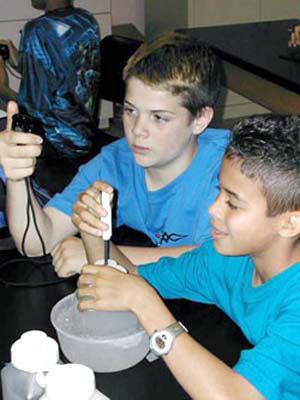 BEAMS students learn about energy transfer, insulators and scientific procedure during the Cold Stuff activity.
Becoming Enthusiastic About Math and Science, or BEAMS, Jefferson Lab's long-running math and science enrichment program needs your help. Staff, users and students interested in assisting with student activities conducted at the lab during normal business hours are encouraged to contact LaChelle Williams, Science Education. BEAMS supports Newport News inner-city public school students as they progress from sixth through eighth grade. Nearly 1,500 students and their teachers visit JLab between two and five days each school year to participate in science and math activities conducted by scientists, engineers, technicians and administrators. Volunteers spend about 75 minutes in a BEAMS classroom (VARC 72A & 72B), either leading an activity or assisting students as they carry out an activity. Volunteers are also needed to provide 15-minute Role Model visits in their office or other appropriate work area for the students. "If you aren't available for a longer activity, Role Model visits are a great way to help out," Williams notes. The 2009-2010 round of BEAMS class visits begin in early October and will run through May 2010. Usually two classes attend at a time and participate in two to four separate activities during each day-long visit. Volunteers are currently needed to lead or help with the following activities: Later in the school year volunteers will be needed to lead or help with these and other activities: "JLab staff, students and users are critical to the success of JLab's science education programs, especially BEAMS," Williams says. "Our BEAMS volunteers have been sharing their passion and excitement for math, science and technology with students for more than 17 years. Students get to learn about you and your job and you get to have fun working with lots of smiling faces. Everybody wins! "From right here at the lab, you have a chance to make a difference in the lives of these students. We're always happy to welcome back volunteers who have helped in the past, and we are eager to welcome first-time volunteers," she adds. "Want to help, but not sure how? That's what we're here for," Williams explains. "Science Education staff will provide the training you need. Members of the Education group are happy to go over any activity whether you are new to the program or if you'd like a refresher. If you want to observe a classroom activity to see if it's something you want to do, we can schedule that." For additional information, class visit schedules and activity opportunities, contact Williams at ext. 7567 or email lachelle@jlab.org. The program's goals include: motivating students to boost their learning; strengthening students' math and science skills with hands-on activities, and having them interact with individuals who use math and/or science in their daily work environment. BEAMS also provides teachers with classroom activities based on JLab science and technology. You may view several of the activities' work sheets at the following pdf links: |
FIRST Robots Come to Life
|
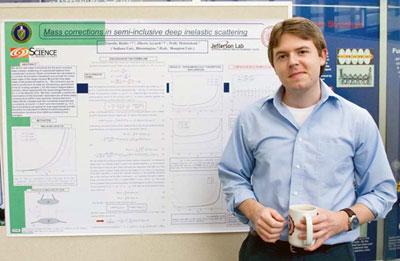 Winning First Place and a $1000 prize in the 2009 JLab Users Group Annual Meeting and Workshop Poster Contest was Timothy Hobbs, Hampton University, with his poster, titled: Mass corrections in semi-inclusive deep inelastic scattering. |
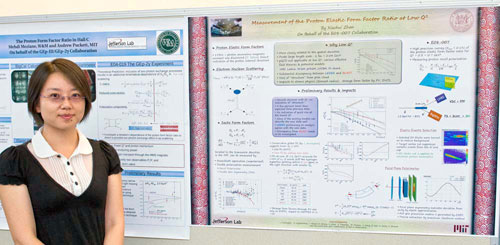 Second Place and a $500 prize was won by Xiaohui Zhan, Massachusetts Institute of Technology, with her poster, titled: A New Measurement of the Proton Elastic Form Factor Ratio at Low Q2. The poster session/contest took place during the reception at the end of the first day of the JLab annual users meeting on June 8. |
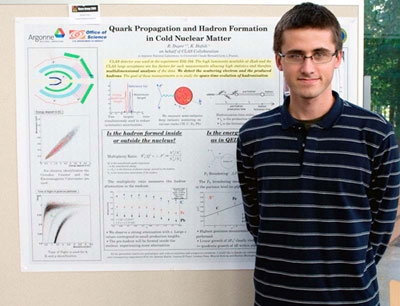 Third Place and a $250 prize was awarded to Raphaël Dupré, Argonne National Laboratory, with his poster, titled: Quark Propagation and Hadron Formation in Cold Nuclear Matter. Thirty-two young scientists submitted posters presenting their JLab-based research at the poster contest. |
Celebrate Year of Astronomy with Special Lecture
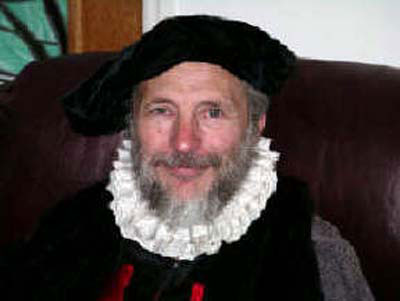
Jefferson Lab will host an entertaining and educational historical interpretation of the life of 16th century astronomer and mathematician Johannes Kepler at its Tuesday, Oct. 20 Science Series lecture.
The presentation, The Founders of Modern Astronomy, will feature John McFarland, a retired high school science teacher, as Johannes Kepler. Dressed in period clothing, he will portray Kepler during his early school years to his time as Imperial Mathematician to the Holy Roman Emperor. He will also highlight the accomplishments of Nicolaus Copernicus, Tycho Brahe, Galileo Galilei and Sir Isaac Newton, with an emphasis on Galileo's astronomical discoveries. The importance of Copernicus' sun-centered universe will be explained, as will Galileo's 1610 discovery of Jupiter's four moons. The discoveries will be explained within the political and religious context of the period.
Four hundred years ago, in 1609, Galileo made the most powerful telescope on the planet and pointed it to the heavens. To commemorate the anniversary, a global effort initiated by the International Astronomical Union and UNESCO has dubbed 2009 the International Year of Astronomy.
The Oct. 20 lecture will start at 7 p.m., last about an hour and include a question-and-answer period at the end. It will take place in Jefferson Lab's CEBAF Center auditorium, located at 12000 Jefferson Ave., Newport News. It is free and open to anyone interested in learning more about science.
For security purposes, enter at JLab's main entrance (Onnes Drive.). Everyone over 16 is asked to carry a valid photo ID. Security guards may perform ID, parcel and vehicle checks. For directions and information about other JLab public lectures, visit http://education.jlab.org/scienceseries/index.php, or contact Christine Wheeler, by email wheelerc@jlab.org or call 757-269-7560
Bertozzi Honored with DNP's First Mentoring Award
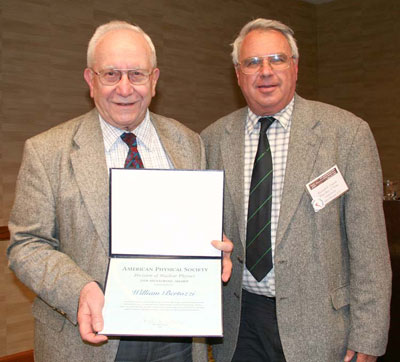
Group Drops 821 Pounds During Biggest Loser Challenge
Dozens of individuals at JLab have become big losers and they are proud of it. In coordination with Occupational Medicine and Human Resources, Jan Tyler, Science Education manager, spearheaded a Biggest Loser challenge at JLab earlier this year.
More than 60 men and women from across the lab signed up for the 12-week weight loss contest that began April 17 and ended July 10. Registration was $20 per person. All of the registration money was awarded to the five individuals losing the largest percentage of their respective body weight at the end of the program. The first-place loser won 50 percent of the money, 2nd place earned 20 percent, 3rd place got 15 percent, 4th place took 10 percent and 5th place walked away with 5 percent of the pot.
Those signing up represented a cross-section of the lab – men, women, younger, older, from both office and technical jobs.
Dr. Smitty Chandler, Occupational Medicine director, emphasized that the purpose of the contest was to provide interested individuals with an enjoyable format in which to monitor their progress while engaging in healthy eating and exercise habits.
To emphasize healthy eating and exercise, a few lunch-time meetings were held on topics like food portion control and exercise options. Many people teamed up with an exercise buddy and took up a fitness activity that ran the gamut from walking, toning (lifting weights) and cardio exercise (line dancing, aerobics, step aerobics, jogging, etc.) in addition to cutting calories.
On July 10, the group met in the VARC lobby to find out who the biggest losers (i.e. winners) were. "The group lost a total of 821.75 pounds, which is awesome," Tyler said. "Thank you all for participating. No gaining back allowed!"
Colleagues are already asking her to run another challenge in the future. Many of the participants said they both benefited from and enjoyed the program, and added that it allowed them to meet people from different parts of the lab.
Winners are as follows:
1st Place: Garry Justice, Engineering Division: winner of $660 and loser of 62 pounds.
2nd Place: Phil Kessler, Project Management and Integration: winner of $264 and loser of 51.25 pounds.
3rd Place: Mike Martin, Environment, Safety, Health and Quality Division: winner of $198 and loser of 67.5 pounds.
4th Place: Jeff Dail, Engineering Division: winner of $132 and loser of 31 pounds.
5th Place: Janet Smith, Office of the Chief Financial Officer: winner of $66 and loser of 29.5 pounds.
Going to the Dogs Supports Good Cause
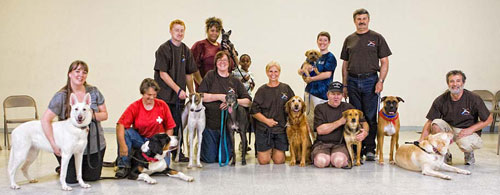
Back Row, standing from left to right: Peter Monaghan, Connie Adams and Gizmo (rat terrier/toy poodle mix), William Whitaker, Jen Monaghan and Shadow (Yorkshire terrier), and Brian Kross and Loki (boxer).
The Jefferson Activities Group Dog Training Club's second group of dogs and handlers were tested for the Canine Good Citizen and Therapy Dog International certification on June 16.
The purpose of the Canine Good Citizen Test, a certification program of the American Kennel Club, is to demonstrate that the dog can be a respected member of the community, and can be trained and conditioned always to behave in the home, in public places and in the presence of other dogs, explained Joyce Miller, dog training club captain and Physics Division staff member.
The primary objective of the Therapy Dog International, dog and handler is to provide comfort and companionship by sharing the dog with patients in hospitals, nursing homes and other institutions.
Along with the group of dogs and handlers who passed the tests in 2008, the JAG Dog Training Club plans to participate in monthly Paws to Read programs at local libraries in Hampton and Tabb. The mission of the Paws to Read program is to improve the literacy skills of children with the assistance of registered canine reading companions in a fun and relaxed environment. Research with therapy animals indicates that children with low self-esteem are often more willing to interact with an animal than another person, according to Miller. The dogs listen uncritically and wag their tails as the kids read. Paws to Read attracts children from all reading levels who come to the library once a month to read to trained therapy dogs.
The CGC/TDI evaluator, Helen Noles, said this about the JAG Dog Training Club group, "The dogs and handlers were wonderful! They are all great dogs and are going to make wonderful therapy dogs!"
The JAG Dog Training Club is open to all JLab employees, users, family members and their dogs. The club meets on Tuesday evenings at 6:30 p.m. at the Beechwood Recreation Center in Denbigh. If you are interested in becoming a member of the dog club and training your dog, contact Joyce Miller, captain, at ext. 7163 or miller@jlab.org , or Brian Kross, co-captain, ext. 7022 or kross@jlab.org.
"Sweet" on Safety Month
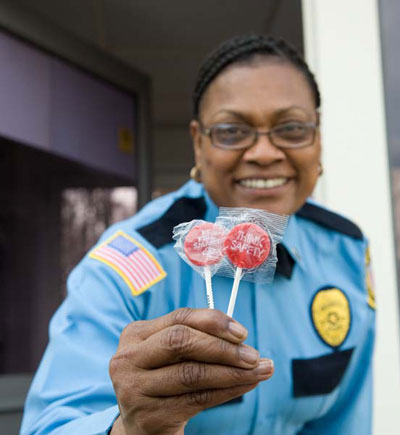
Lieutenant Carroll Burnette, a Top Guard Security Officer assigned to Jefferson Lab, hands out "Think Safety" lollipops to JLab staff and users entering the Accelerator Site. Top Guard officers passed out 300 lollipops and 3000 "Safety First" mints during June – raising safety awareness with a smile and the sweet reminders. This is the third year that Top Guard has distributed small treats imprinted with safety messages.
To keep safety at the forefront of their work, Top Guard has a monthly calendar that provides a JLab specific safety tip for each day. Safety tips are briefed at the beginning of each shift and are shared with the JLab community. Recently Chris Stuart, Top Guard’s Vice President of Client Relations & Business Development, spoke with JLab's Worker Safety Committee to share with them what Top Guard officers are doing to promote safety awareness and safe practices.
June of each year has been designated National Safety Month. The federal government, states and many businesses and industry encourage involvement and raised awareness on a range of safety issues and concerns with the goal of reducing injuries both on and off the job.
Many activities and informational material for the awareness month is provided by the National Safety Council.
Milestones for July through mid-September 2009
Hello
Keith Blackburn, Mechanical Technician, Free-Electron Laser Division
Maria Chevtsova, Research Student Intern, Accelerator Division
Alina Dolgolenko, Physics Student Intern, Physics Division
Chase Dubbe, Mechanical Engineer, Engineering Division
Pavel Evtushenko, FEL staff scientist, transfer to the Free-Electron Laser Division
Maya Keller, Accelerator Health Physicist, Environment, Safety, Health & Quality Division
Michelle Lechman, Public Affairs Associate, Chief Operating Officer Division
Tina Menefee, Safety Warden Coordinator, transfer to the Environment, Safety, Health and Quality Division
William Mooney, Energy and Resource Conservation Engineer, Chief Operating Officer Division
Bernhard Musch, Post Doctoral Fellow, Chief Scientist Officer Division
Satoshi Nakamura, EBAC Post Doctoral Fellow, Chief Scientist Officer Division
Andre Newman, Vacuum Technologist, Engineering Division
Joshua Pierce, Cryogenic/Polarized Target Physicist, Physics Division
Lionel Quettier, Superconducting Magnet Mechanical Engineer, Engineering Division
Shannon Ritter, Design Student Intern, Chief Operating Officer Division
Bradley Sawatzky, Experimental Hall C Physicist, Physics Division
Robert Sperlazza, Facilities Maintenance Manager, Chief Operating Officer Division
Balsa Terzic, CASA Scientist, Accelerator Division
Jason Willoughby, Student Engineering Draftsperson, Chief Operating Officer Division
Glenn Young, 12 GeV Associate Project Manager, 12 GeV Upgrade Team
Goodbye
Robert Ewing, Environment, Safety, Health & Quality Division
Hrishikesh Phadke, Engineering Division
These Milestone entries, listed alphabetically, are full-time, term, casual and student actions posted by Human Resources from July through mid-September 2009.
Approximately two dozen JLab career opportunities are currently posted at: https://careers.peopleclick.com/careerscp/client_jeffersonlab/external/search.do
For more information about employment at JLab, visit: http://www.jlab.org/div_dept/admin/HR/index.html
JLab Careers are also posted under the Popular Applications listing on JLab's internal Insight page.


 In the fall, Gianluigi (Gigi) Ciovati will visit the White House to receive a 2009 Presidential Early Career Award for Scientists and Engineers, the highest honor bestowed by the U.S. government on outstanding scientists and engineers who are early in their independent research careers......
In the fall, Gianluigi (Gigi) Ciovati will visit the White House to receive a 2009 Presidential Early Career Award for Scientists and Engineers, the highest honor bestowed by the U.S. government on outstanding scientists and engineers who are early in their independent research careers...... Jefferson Lab's Continuous Electron Beam Accelerator Facility is set to undergo its first major upgrade, a $310 million project to enhance the facility's research capabilities. To make it possible, designers are filling in "extra space" in the linear accelerators or straight sections of the machine with additional accelerator components......
Jefferson Lab's Continuous Electron Beam Accelerator Facility is set to undergo its first major upgrade, a $310 million project to enhance the facility's research capabilities. To make it possible, designers are filling in "extra space" in the linear accelerators or straight sections of the machine with additional accelerator components...... Becoming Enthusiastic About Math and Science, or BEAMS, Jefferson Lab's long-running math and science enrichment program needs your help. Staff, users and students interested in assisting with student activities conducted at the lab during normal business hours are encouraged to contact LaChelle Williams, Science Education.......
Becoming Enthusiastic About Math and Science, or BEAMS, Jefferson Lab's long-running math and science enrichment program needs your help. Staff, users and students interested in assisting with student activities conducted at the lab during normal business hours are encouraged to contact LaChelle Williams, Science Education.......